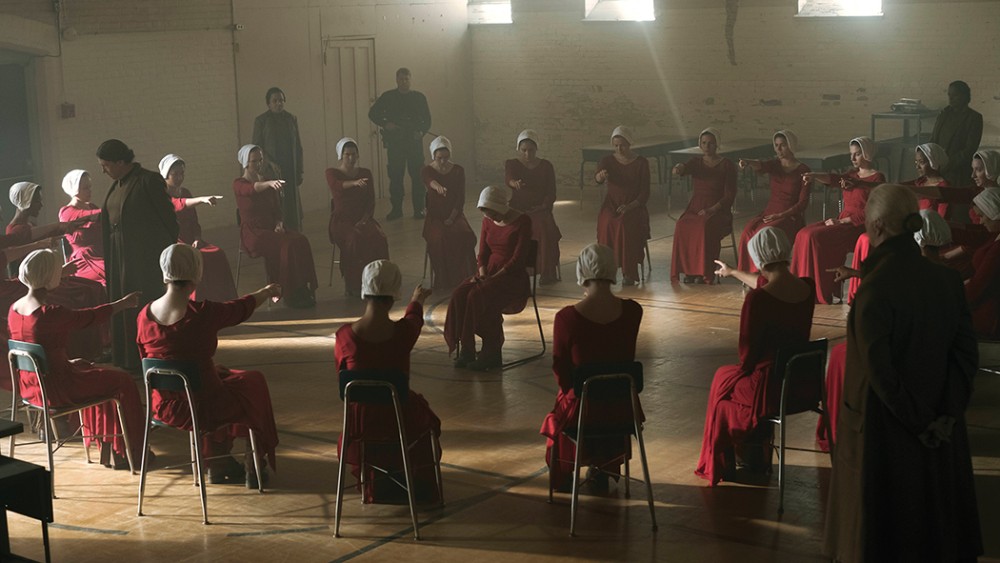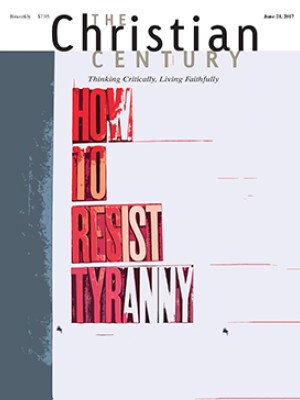Why I find The Handmaid's Tale surprisingly comforting
Resistance might not achieve its outer aims. Nevertheless, its inner life persists.

When I first read Margaret Atwood’s 1985 novel The Handmaid’s Tale, I was a junior in college. The book seemed insightful the way zombie apocalypse is insightful: an outlandish parable of the desire to control women’s bodies and choices, an interesting litmus test of how far feminism had come, or how far it still had to go.
Reading it again this year and watching the new Hulu television adaptation, it feels like just the story that we need right now. Not as a political allegory as much as an exploration of the inner life of resistance.
If you haven’t read the book, watched the TV show, or read one of the many related think pieces that are circulating on social media, let me catch you up: in the very near future the global fertility rate has dropped to near zero. In this social and political instability, a patriarchal theocracy replaces the United States with a state called Gilead, where women are stripped of all civil rights and parceled out to men as wives, domestic labor, or Handmaids—fertile women who will conceive children in the place of barren wives.
Read our latest issue or browse back issues.
Much ado has been made about if and how far-right Christian fundamentalism could devolve into Gilead. Are laws against abortion the first step toward sexual slavery? Is Mike Pence really a Christo-fascist who would enact Levitical law if given a chance?
Finding too close a comparison between our current political situation and the dystopian fantasy is a genre mistake. Dystopias imagine the impossible-to-imagine: civilization destroyed by nuclear holocaust, zombie hoards, or alien invasion. Atwood’s political point seems to be less “first they won’t fund birth control, then they’ll use women as sexual surrogates” than to see how a threat to the species—long-term worldwide global infertility—would lend credence to ideologies that scapegoat women in extreme but all too familiar ways. Atwood forces us to imagine how quickly authoritarian white supremacist patriarchy would rear its head if faced with an end-of-the world reality. And how much harder an authoritarian regime is to resist than zombie hoards.
Resistance, even more than dystopia, is central to the story. As much as collective pop culture loves zombie apocalypse, it loves resistance stories more. Star Wars is built around a rebellion (and in the newest episodes, the Resistance). The Hunger Games and Harry Potter are resistance tales: young heroes, with archery skills or extraordinary origin stories, teach resistance in the face of overwhelming evil. Hamilton imagines our national origin story as a scrappy band of rebels resisting their way to a new republic. The rallying cry of its resistance anthem (“Rise up! When you’re living on your knees you rise up!”) has become the slogan of both the new season of The Walking Dead (zombie apocalypse plus resistance!) and Underground. We are a nation of heroes and our heroes resist.
The Handmaid at the center of the story—named Offred in the novel, June in the TV series—is not your usual resistance hero. In the novel, the Handmaid stumbles toward resistance through her inner monologue. We hear how terrified she is, how confused. She knows that she is being watched, not just for outright disobedience, but for clues that she accepts the situation of her rape and imprisonment. She can feel her inner life shifting in line with the values she submits to in order to survive. When a group of Japanese tourists gawk at her head-to-toe red dress and the head covering that obscures her face, she finds herself mildly horrified by their garish makeup and bare legs. She is, as feminist theory teaches us, internalizing the patriarchy that controls her, even as she tries to resist it.
Internal resistance is a hard thing to visualize, but one thing that makes the TV adaptation so compelling is how magnificently Elisabeth Moss, who plays June, manifests this inner struggle. In one scene, June has frustrated her commander (Joseph Fiennes). In one of their secret late-night meetings for Scrabble, outside their monthly orchestrated rape ritual, she has grown too bold in speaking out to him. Told to go back to her room, June stands at the door, facing the camera. She looks panicked, at once proud of her bravado and terrified. Registering the variations in her inner life with the slightest movements of her mouth, the set of her eyes, the tension of her fingers, she recomposes her body and turns around to appease him. She is playing a symphony of resistance, if you know how to recognize it.
In the novel, the Handmaid does not bring down Gilead. The Handmaid risks everything for something that cannot be measured by her in her lifetime. The value of resistance is in her inner life and in whatever hope she gives others by telling her story. Her victory is holding onto her moral compass and putting one foot in front of the other every day.
After several episodes in the TV series, June had already turned into something of a rebel: she openly confronts the Mexican ambassador and seeks out the underground resistance. It is exhilarating to watch because most resistance stories teach us to desire heroic action that results in death or salvation (or salvation through death).
It is a strange thing to wish for, but I found myself hoping the series would end without heroics. I am finding new comfort in the Handmaid. She is teaching me resistance as an inner disposition, which persists even if it cannot achieve all its outer aims.
Unlike the Handmaid, there are many avenues of action available to us, and resistance is a new watchword mobilizing political agency. But also unlike the Handmaid, I cannot simply wish to blow up the system because that system contains my relatives who vote differently than me and my neighbors, who stand to suffer far more than I would by political instability. Resistance, as the Handmaid knows, must be as much about persistence as it is about winning. The Handmaid’s Tale may not be a reliable political allegory, but its models for resistance may be needed even more in 2017 than in 1985.
A version of this article appears in the June 21 print edition under the title “Resistance on the inside.”







